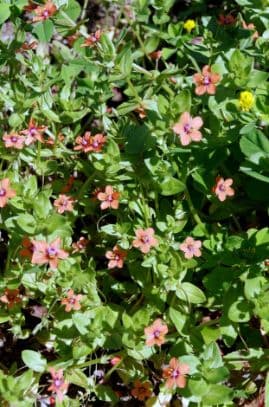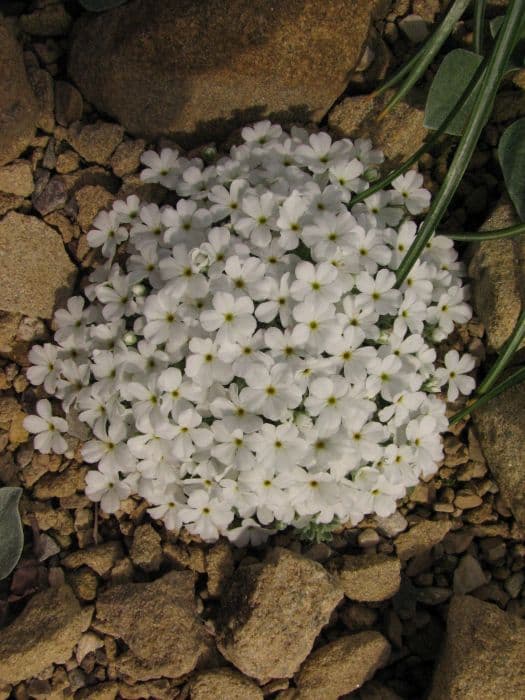Orchid Primrose Primula vialii (So)

ABOUT
Primula vialii, also known as the orchid primrose, is a perennial plant known for its unique and striking flower spikes that emerge in early to midsummer. The flower spikes are densely packed with tiny buds that open from the bottom upwards. These blossoms present a two-tone color display: the buds at the tip are typically a vibrant red or purple, whereas the lower flowers that open first are a contrasting shade of blue or violet. The overall visual effect is reminiscent of a poker or a torch, which gives it an exotic and eye-catching appearance. The foliage of the orchid primrose forms a basal rosette of tongue-shaped leaves that are deep green in color, with a crinkled or wrinkled texture. The leaves are somewhat elongated, with a slight taper towards the tip, and the edges can be subtly toothed or scalloped. The plant presents a lush, verdant backdrop for the dramatic, upright flower spikes that rise above the leaves during blooming season. The orchid primrose is often appreciated for its ornamental appeal in garden settings, where it provides a splash of intense color and an interesting vertical element due to the form of its flower spikes. It adds visual interest when planted in groups or amidst other garden plants that complement its unique appearance.
About this plant
 Names
NamesFamily
Primulaceae.
Synonyms
Orchid Primrose, Vial's Primula, Red Hot Poker Primula, Chinese Pagoda Primrose.
Common names
Cortusa vialii, Primula littoniana, Primula poissonii, Primula viali.
 Toxicity
ToxicityTo humans
Orchid Primrose (Primula vialii) is generally considered non-toxic to humans. Therefore, accidental ingestion is unlikely to cause serious symptoms or long-term health consequences. However, as with any plant not intended for consumption, individual allergies or sensitivities may cause mild gastrointestinal discomfort, nausea, or irritation of the mouth and throat if ingested.
To pets
Orchid Primrose (Primula vialii) is generally considered non-toxic to pets. It does not contain any known toxic compounds that would cause serious illness or poisoning in animals such as dogs or cats. If pets ingest part of this plant, they may experience mild gastrointestinal upset due to the plant's foreign nature in their diet, but significant toxicity is not expected.
 Characteristics
CharacteristicsLife cycle
Perennials
Foliage type
Deciduous
Color of leaves
Green
Flower color
Mixed
Height
1-2 feet (30-60 cm)
Spread
1 foot (30 cm)
Plant type
Herb
Hardiness zones
5
Native area
China
Benefits
 General Benefits
General Benefits- Ornamental Value: Primula vialii, commonly known as the Orchid Primrose, offers striking spires of pink and lavender flowers, adding a unique visual appeal to gardens.
- Attracts Pollinators: The colorful flowers of the Orchid Primrose attract bees, butterflies, and other beneficial insects, facilitating pollination in the garden.
- Easy to Grow: With proper care, the Orchid Primrose can be easy to cultivate, making it a good choice for both novice and experienced gardeners.
- Compact Size: Due to its modest size, Primula vialii is well-suited for rock gardens, borders, and small spaces where larger plants might not fit.
- Versatile Planting Options: It can be planted in a variety of settings such as containers, beds, and borders, offering flexibility in garden design.
- Seasonal Interest: The Orchid Primrose provides early to mid-summer interest in the garden when many spring flowers have finished blooming.
- Moisture Indicator: Being a moisture-loving plant, Primula vialii can serve as a natural indicator of soil moisture levels in the garden.
 Medical Properties
Medical PropertiesThis plant is not used for medical purposes.
 Air-purifying Qualities
Air-purifying QualitiesThis plant is not specifically known for air purifying qualities.
 Other Uses
Other Uses- In crafting, the cone-shaped flowers of Primula vialii, also known as the orchid primrose, can be dried and used to create unique floral arrangements or as components in making potpourri.
- The orchid primrose's vibrant dual-toned spikes may serve as a natural dye source for fabrics or arts, where its pigments can be extracted to produce delicate shades of red and purple.
- This flower can be used in photography sessions as a captivating subject or as a natural backdrop to enhance the composition and color contrast of the images.
- For educational purposes, Primula vialii is a candidate for botanical studies due to its unique inflorescence and growth patterns, teaching about plant biology and pollination.
- During ecological landscaping, this species can be integrated into wildlife gardens to attract pollinators like bees, butterflies, and other beneficial insects which enjoy their nectar.
- Orchid primrose can play a role in stress relief by being included in sensory gardens due to its striking appearance and potential for tactile interaction with its unusual flower spikes.
- The plant can be used as a natural indicator for gardeners of soil conditions and moisture levels based on its growth behavior and robustness.
- In art, the orchid primrose can be incorporated into floral designs and motifs for inclusion in paintings, textiles, and decorative wallpapers.
- With learner gardeners, Primula vialii can be utilized as an educational tool, illustrating the principles of perennial plant care and division.
- Their unique appearance makes them an excellent choice for thematic gardens, like fairy or fantasy gardens, where they contribute to creating a magical and enchanted atmosphere.
Interesting Facts
 Feng Shui
Feng ShuiThe plant Primula vialii is not used in Feng Shui practice.
 Zodiac Sign Compitability
Zodiac Sign CompitabilityPrimula vialii is not used in astrology practice.
 Plant Symbolism
Plant Symbolism- Uniqueness and Distinctiveness - Primula vialii, also known as the Orchid Primrose, is recognized for its unique flower structure and intense coloration, symbolizing the value of being different and standing out in a crowd.
- Youth and New Beginnings - Primroses in general are associated with youth and renewal, as they are often some of the first flowers to bloom in spring.
- Innocence and Tranquility - The delicate and peaceful appearance of the Orchid Primrose is sometimes associated with purity, innocence, and a serene environment.
- Happiness and Positivity - With its bright and cheerful flowers, the Orchid Primrose is thought to embody joy and optimism, bringing a positive outlook to life.
- Eternal Love - In the language of flowers, primroses can represent the concept of everlasting love, suggesting a deep and enduring affection.
 Water
WaterFor the Primula vialii, also known as the Orchid Primrose, it's essential to maintain consistent moisture without waterlogging the plant. Water the Orchid Primrose thoroughly when the top inch of soil feels dry, typically once a week, using about 0.5 gallons per watering for an average-sized plant. During the active growing season in spring and summer, you may need to water more frequently, especially if the weather is particularly warm or windy. In the winter, reduce watering to every other week or when the soil is noticeably dry, as the plant requires less moisture during dormancy.
 Light
LightThe Orchid Primrose thrives in partial shade where it can receive filtered sunlight. It's best situated in a spot that is protected from the harsh afternoon sun to prevent leaf burn. A north-facing or east-facing location with bright, indirect light is ideal for the Orchid Primrose. Ensure that it gets ample light but is shielded from direct, intense rays, especially during the midday when the sun is at its strongest.
 Temperature
TemperatureThe Orchid Primrose prefers cool to moderate temperatures, ideally ranging between 50°F and 72°F. It can withstand short periods of colder weather down to about 40°F but should be protected from frost. Avoid exposure to temperatures above 80°F, as this can stress the plant and lead to poor growth or damage. The Orchid Primrose's comfort zone aligns with typical indoor temperatures, making it a suitable houseplant.
 Pruning
PruningPruning the Orchid Primrose is crucial for maintaining its health and encouraging lush growth. Deadhead spent flowers regularly to promote continuous blooming. After blooming, trim back the foliage to tidy up the plant and stimulate new growth. The best time for a more thorough pruning is in late winter or early spring before new growth begins.
 Cleaning
CleaningAs needed
 Soil
SoilThe Orchid Primrose (Primula vialii) prefers moist, well-drained soil with a high organic content, ideally a mix of peat, loam, and sand. The best pH range for the Orchid Primrose is slightly acidic to neutral, around pH 5.5 to 7.0.
 Repotting
RepottingOrchid Primrose should be repotted every one to two years to refresh the soil and accommodate the growth of the plant. It's best to repot in the spring, just before the growing season begins.
 Humidity & Misting
Humidity & MistingOrchid Primrose thrives in environments with high humidity levels, ideally between 50-70%. It is important to maintain a consistently humid atmosphere for the health of the plant.
 Suitable locations
Suitable locationsIndoor
Provide bright, indirect light and high humidity.
Outdoor
Plant in partial shade, moist soil, protect from harsh sun.
Hardiness zone
5-7 USDA
 Life cycle
Life cyclePrimula vialii, commonly known as Orchid Primrose, begins its life as a seed, typically sown in late winter or early spring. Upon germination, the seed forms a tiny rosette of leaves at the soil surface, entering into a vegetative stage of growth. As the plant matures, it develops a sturdy stem and a more pronounced leaf rosette. In early to mid-summer, Orchid Primrose produces a distinctive spike of tiered pink and purple flowers arranged in a conical shape, which are highly attractive to pollinators. After flowering, seeds are produced and dispersed, completing the reproductive cycle. The plant then enters a period of dormancy during colder months, especially in regions with freezing temperatures, before resuming growth in the following spring.
 Propogation
PropogationPropogation time
Spring to Summer
Propogation: The most popular method of propagating Primula vialii, commonly known as the Orchid Primrose, is by sowing seeds. The best time to propagate these plants by seed is late winter or early spring. To do this, you would scatter the seeds over a tray filled with a well-draining seed starting mix. It's critical to only lightly cover the seeds, if at all, as they require light to germinate. The tray should then be placed under grow lights or in a bright spot but not in direct sunlight, and kept at a consistent temperature of about 59-65 degrees Fahrenheit (15-18 degrees Celsius). Keep the soil moist but not waterlogged. Germination can take anywhere from 14 to 30 days. Once seedlings have reached a sufficient size and there is no longer a risk of frost, they can be transplanted outdoors into the garden.









